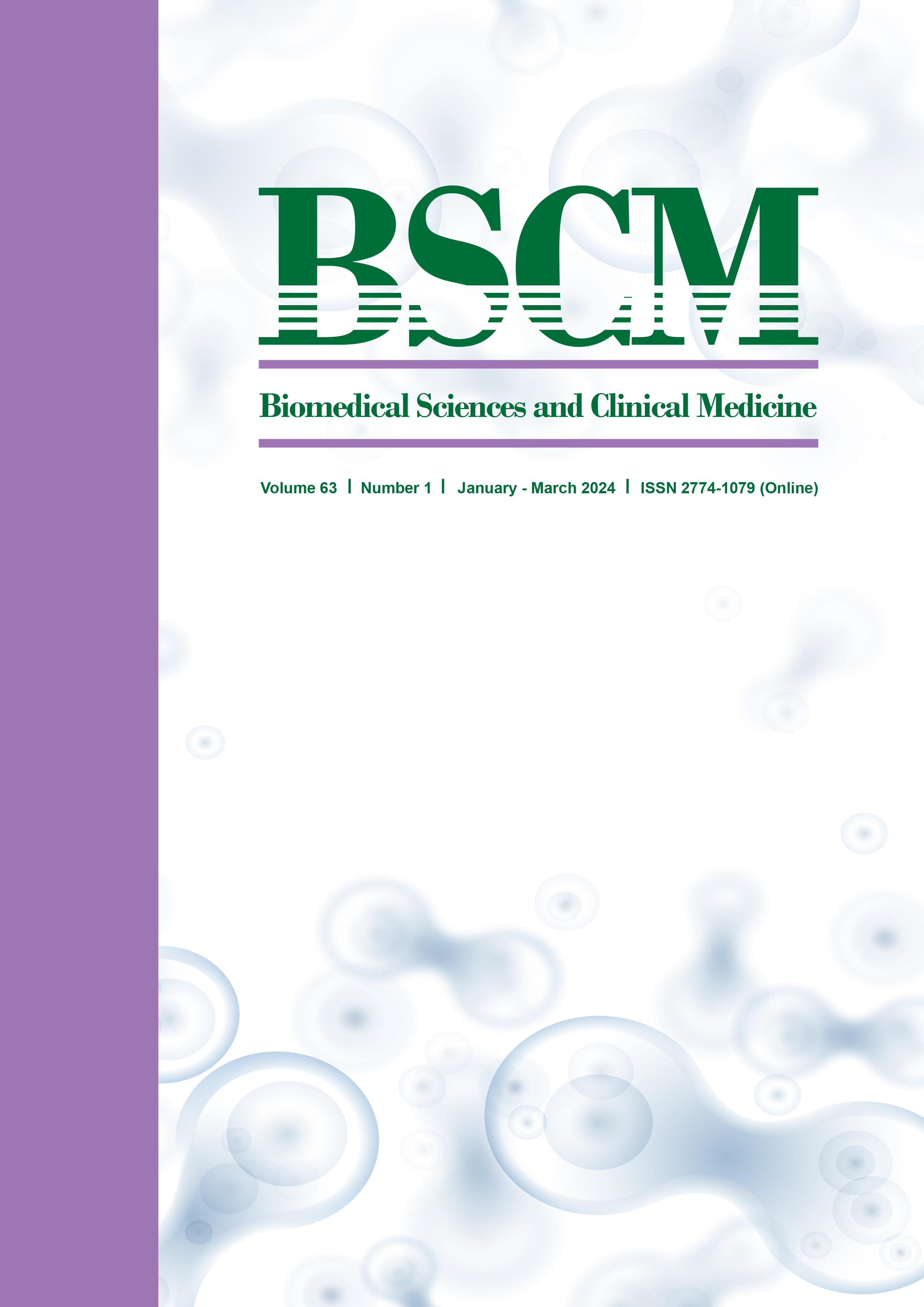Does chin-throat length relate to oropharyngeal volume, minimum axial area, and polysomnographic indices?
Main Article Content
Abstract
Objective To evaluate the correlation between chin-throat length and oropharyngeal volume, minimum axial area, and polysomnographic indices in patients undergoing orthodontic treatment.
Methods The study enrolled 73 patients (35 men and 38 women) who met the inclusion criteria. The face scanner created a 3D facial simulation, and chin-throat length was subsequently measured. 3D CBCT images were used to simulate 2D lateral cephalometric images. Oropharyngeal volume and minimum axial area were determined using Dolphin imaging software, and airway function was assessed through unattended at-home overnight polysomnography. Pearson correlation coefficients were then used to determine the correlations between chin-throat length and oropharyngeal volume, minimum axial area, and polysomnographic indices. Additional correlations were explored between age, BMI, cephalometric variables, and oropharyngeal volume, and minimum axial area. Finally, multiple regression analysis was used to analyse the factors having an influence on the correlations.
Results Chin-throat length was positively correlated with oropharyngeal volume and minimum axial area. SNB, ANB, Co-Gn, and Go-Gn were also observed to be positively correlated with oropharyngeal volume and minimum axial area. Multiple regression analysis demonstrated that the factor influencing the correlation of chin-throat length with oropharyngeal volume and with minimum axial area was mandibular length; however, the correlations were only observed among men. No correlation was evident between chin-throat length and polysomnographic indices.
Conclusions Chin-throat length is positively correlated with oropharyngeal volume and minimum axial area but has no association with polysomnographic indices. Mandibular length may influence upper airway dimensions.
Article Details

This work is licensed under a Creative Commons Attribution 4.0 International License.
References
Senaratna C, Perret J, Lodge C, Lowe A, Campbell B, Matheson M, et al. Prevalence of obstructive sleep apnea in the general population: A systematic review. Sleep Med Rev. 2017;34:70-81.
Spicuzza L, Caruso D, Di Maria G. Obstructive sleep apnoea syndrome and its management. Ther Adv Chronic Dis. 2015;6:273-85.
Sutherland K, Lee R, Cistulli P. Obesity and craniofacial structure as risk factors for obstructive sleep apnoea: impact of ethnicity. 2012;17:213-22.
Kimoff R. “Obstructive sleep apnea,” in Murray and Nadel’s textbook of respiratory medicine. 6th ed. Philadelphia, PA, United States: Elsevier; 2016. p. 1552-68.
Banhiran W, Durongphan A, Saleesing C, Chongkolwatana C. Diagnostic properties of the STOP-Bang and its modified version in screening for obstructive sleep apnea in Thai patients. J Med Assoc Thai. 2014;97:644-54.
Hong J, Oh K, Kim B, Kim Y, Park Y, orthopedics d. Three-dimensional analysis of pharyngeal airway volume in adults with anterior position of the mandible. 2011;140:e161-e9. Pubmed PMID: 21967954
Liistro G, Rombaux P, Belge C, Dury M, Aubert G, Rodenstein D. High Mallampati score and nasal obstruction are associated risk factors for obstructive sleep apnoea. Eur Respir J. 2003;21:248-52.
Kawaguchi Y, Fukumoto S, Inaba M, Koyama H, Shoji T, Shoji S, et al. Different Impacts of neck circumference and visceral obesity on the severity of obstructive sleep apnea syndrome. Obesity. 2011;19:276-82.
Haddad R, Ghafari J. Chin-throat anatomy: Normal relations and changes following orthognathic surgery and growth modification. Angle Orthod. 2017;87:696-702.
Bergman R. Cephalometric soft tissue facial analysis. Am J Orthod Dentofacial Orthop. 1999;116:373-89.
Naini FB, Gill DS, editors. Orthognathic surgery: principles, planning and practice. New York: John Wiley & Sons; 2016.
Guijarro-Martínez R, Swennen G. Three-dimensional cone beam computed tomography definition of the anatomical subregions of the upper airway: a validation study. Int J Oral Maxillofac Surg. 2013;42:1140-9.
Muto T, Takeda S, Kanazawa M, Yamazaki A, Fujiwara Y, Mizoguchi I. The effect of head posture on the pharyngeal airway space (PAS). Int J Oral Maxillofac Surg. 2002;31:579-83.
Lenza M, Lenza M, Dalstra M, Melsen B, Cattaneo P. An analysis of different approaches to the assessment of upper airway morphology: a CBCT study. Orthod Craniofac Res. 2010;13:96-105.
Tsuiki S, Almeida F, Bhalla P, Lowe A, Fleetham J. Supine-dependent changes in upper airway size in awake obstructive sleep apnea patients. Sleep Breath. 2003;7:43-50.
Lee R, Sutherland K, Chan A, Zeng B, Grunstein R, Darendeliler M, et al. Relationship between surface facial dimensions and upper airway structures in obstructive sleep apnea. Sleep. 2010;33:1249-54.
Reyneke J, Ferretti C. Clinical assessment of the face. Semin Orthod. 2012;18:172-186.
Ghassemi M, Hilgers R, Jamilian A, Hölzle F, Fritz U, Gerressen M, et al. Consideration of effect of the amount of mandibular setback on the submental region in the planning of orthodontic–orthognathic treatment. Br J Oral Maxillofac Surg. 2014;52:334-9.
Wang R, Ho C, Lin H, Lo L. Three-dimensional cephalometry for orthognathic planning: Normative data and analyses. J Formos Med Assoc. 2020;119:191-203.
Sahoo N, Agarwal S, Datana S, Bhandari S. Effect of mandibular advancement surgery on tongue length and height and its correlation with upper airway dimensions. J Maxillofac Oral Surg. 2020;19:624-9.
El H, Palomo JM. Airway volume for different dentofacial skeletal patterns. Am J Orthod Dentofacial Orthop. 2011;139: e511-21. Pubmed PMID: 21640863
Zheng Z, Yamaguchi T, Kurihara A, Li H, Maki K. Three‐dimensional evaluation of upper airway in patients with different anteroposterior skeletal patterns. 2014;17:38-48.
Lan Z, Itoi A, Takashima M, Oda M, Tomoda K. Difference of pharyngeal morphology and mechanical property between OSAHS patients and normal subjects. Auris Nasus Larynx. 2006;33:433-9.
Li H, Lu X, Shi J, Shi H. Measurements of normal upper airway assessed by 3-dimensional computed tomography in Chinese children and adolescents. 2011;75:1240-6.
Liang X, Lu Z, Wu P, Guan Y, Zhou P, Zeng J. Relationship between upper airway volume and polysomnography parameters of patients with obstructive sleep apnea hypopnea syndrome. Lin Chuang Er Bi Yan Hou Tou Jing Wai Ke Za Zhi. 2018;32:1409-13.
Mirrakhimov A, Sooronbaev T, Mirrakhimov E. Prevalence of obstructive sleep apnea in Asian adults: a systematic review of the literature. BMC Pulm Med. 2013;13:10. Pubmed PMID: 23433391
Hsu W, Wu T. Comparison of upper airway measurement by lateral cephalogram in upright position and CBCT in supine position. J Dent Sci. 2019;14:185-91.
Alsufyani N, Al-Saleh M, Major P. CBCT assessment of upper airway changes and treatment outcomes of obstructive sleep apnoea: a systematic review. Sleep Breath. 2013;17:911-23.


